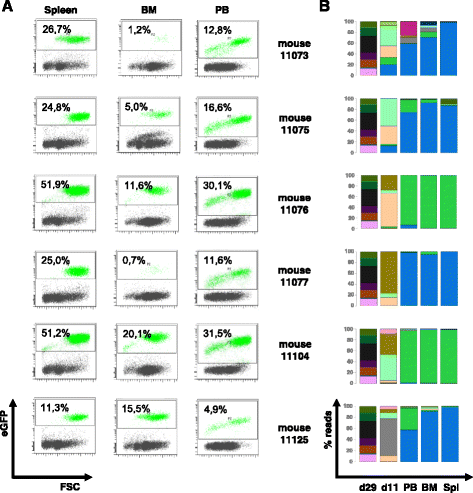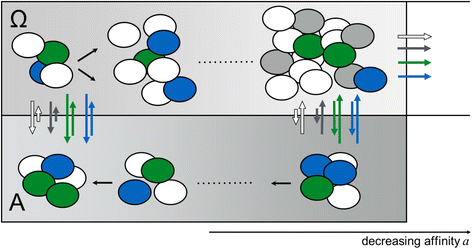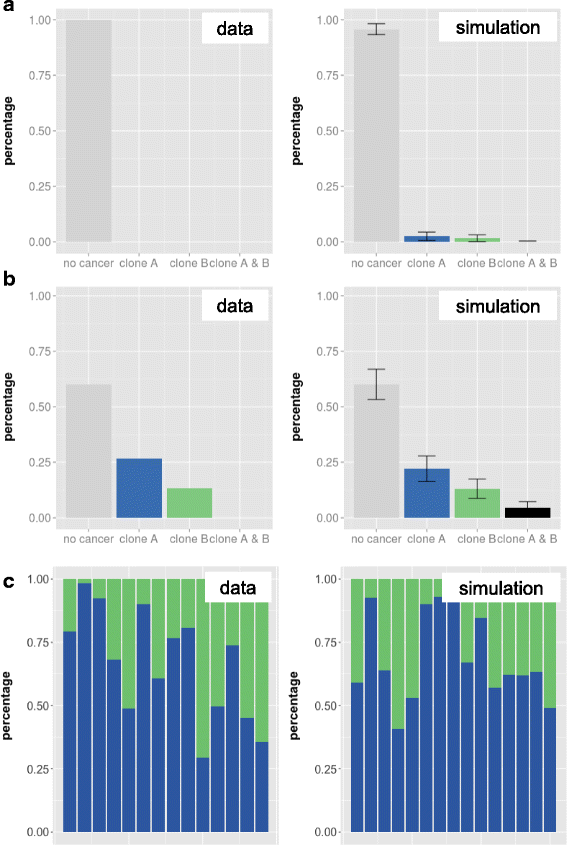Clonal competition in BcrAbl-driven leukemia: how transplantations can accelerate clonal conversion
- PMID: 28709463
- PMCID: PMC5512731
- DOI: 10.1186/s12943-017-0668-x
Clonal competition in BcrAbl-driven leukemia: how transplantations can accelerate clonal conversion
Abstract
Background: Clonal competition in cancer describes the process in which the progeny of a cell clone supersedes or succumbs to other competing clones due to differences in their functional characteristics, mostly based on subsequently acquired mutations. Even though the patterns of those mutations are well explored in many tumors, the dynamical process of clonal selection is underexposed.
Methods: We studied the dynamics of clonal competition in a BcrAbl-induced leukemia using a γ-retroviral vector library encoding the oncogene in conjunction with genetic barcodes. To this end, we studied the growth dynamics of transduced cells on the clonal level both in vitro and in vivo in transplanted mice.
Results: While we detected moderate changes in clonal abundancies in vitro, we observed monoclonal leukemias in 6/30 mice after transplantation, which intriguingly were caused by only two different BcrAbl clones. To analyze the success of these clones, we applied a mathematical model of hematopoietic tissue maintenance, which indicated that a differential engraftment capacity of these two dominant clones provides a possible explanation of our observations. These findings were further supported by additional transplantation experiments and increased BcrAbl transcript levels in both clones.
Conclusion: Our findings show that clonal competition is not an absolute process based on mutations, but highly dependent on selection mechanisms in a given environmental context.
Keywords: BcrAbl; Clonal competition; Clonal dynamics; Genetic barcodes; Heterogeneity; Leukemia; Mathematical modelling.
Figures






Similar articles
-
Ribozyme-mediated cleavage of the BCRABL oncogene transcript: in vitro cleavage of RNA and in vivo loss of P210 protein-kinase activity.Oncogene. 1993 Nov;8(11):3183-8. Oncogene. 1993. PMID: 8414522
-
Detection of chemotherapy-resistant patient-derived acute lymphoblastic leukemia clones in murine xenografts using cellular barcodes.Exp Hematol. 2020 Nov;91:46-54. doi: 10.1016/j.exphem.2020.09.188. Epub 2020 Sep 15. Exp Hematol. 2020. PMID: 32946982
-
Dose-dependent effects of Bcr-Abl in cell line models of different stages of chronic myeloid leukemia.Oncogene. 2005 Sep 22;24(42):6432-40. doi: 10.1038/sj.onc.1208796. Oncogene. 2005. PMID: 16007188
-
Clonal Architecture and Evolutionary Dynamics in Acute Myeloid Leukemias.Cancers (Basel). 2021 Sep 29;13(19):4887. doi: 10.3390/cancers13194887. Cancers (Basel). 2021. PMID: 34638371 Free PMC article. Review.
-
Cell competition and cancer from Drosophila to mammals.Oncogenesis. 2024 Jan 3;13(1):1. doi: 10.1038/s41389-023-00505-y. Oncogenesis. 2024. PMID: 38172609 Free PMC article. Review.
Cited by
-
Immune mechanisms shape the clonal landscape during early progression of prostate cancer.Dev Cell. 2023 Jun 19;58(12):1071-1086.e8. doi: 10.1016/j.devcel.2023.04.010. Epub 2023 May 5. Dev Cell. 2023. PMID: 37148881 Free PMC article.
-
DNA Barcoding Reveals Habitual Clonal Dominance of Myeloma Plasma Cells in the Bone Marrow Microenvironment.Neoplasia. 2017 Dec;19(12):972-981. doi: 10.1016/j.neo.2017.09.004. Epub 2017 Nov 5. Neoplasia. 2017. PMID: 29091798 Free PMC article.
References
Publication types
MeSH terms
Substances
LinkOut - more resources
Full Text Sources
Other Literature Sources
Medical

